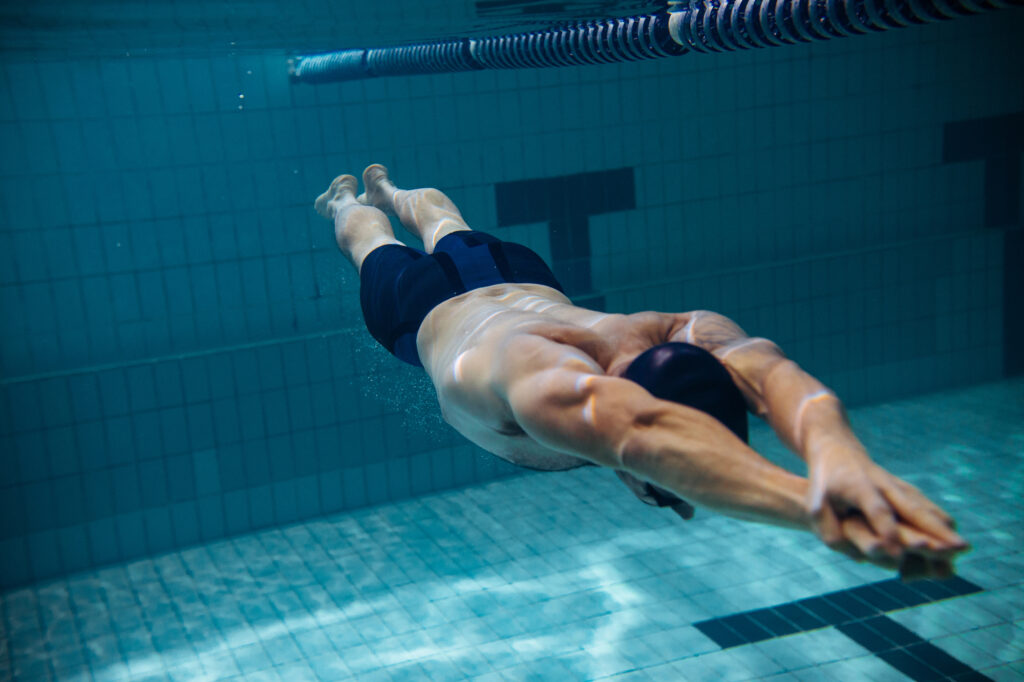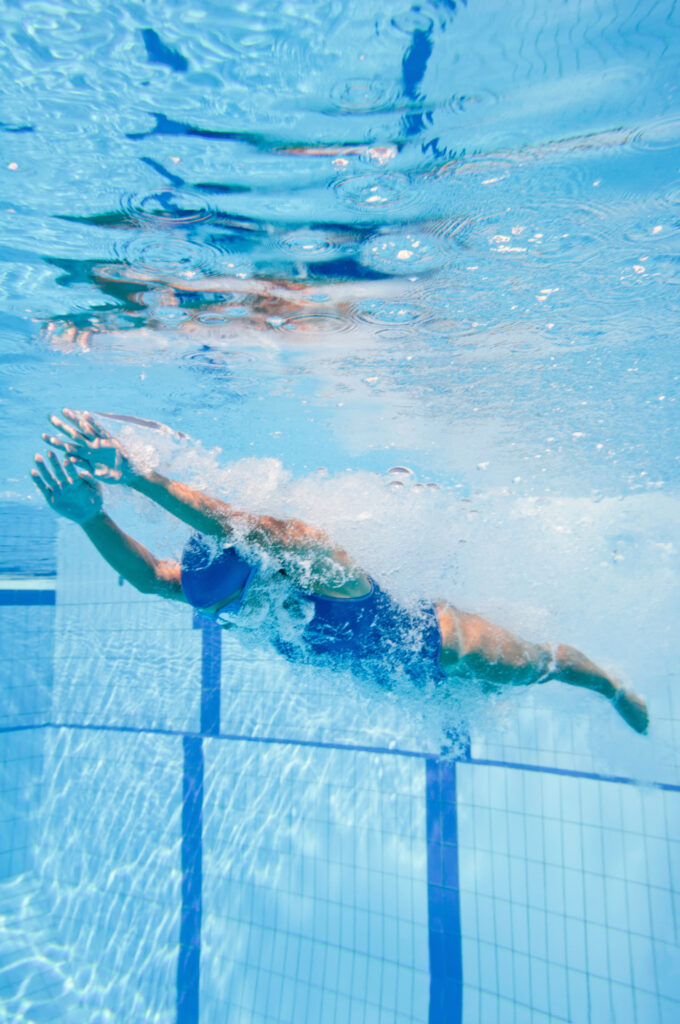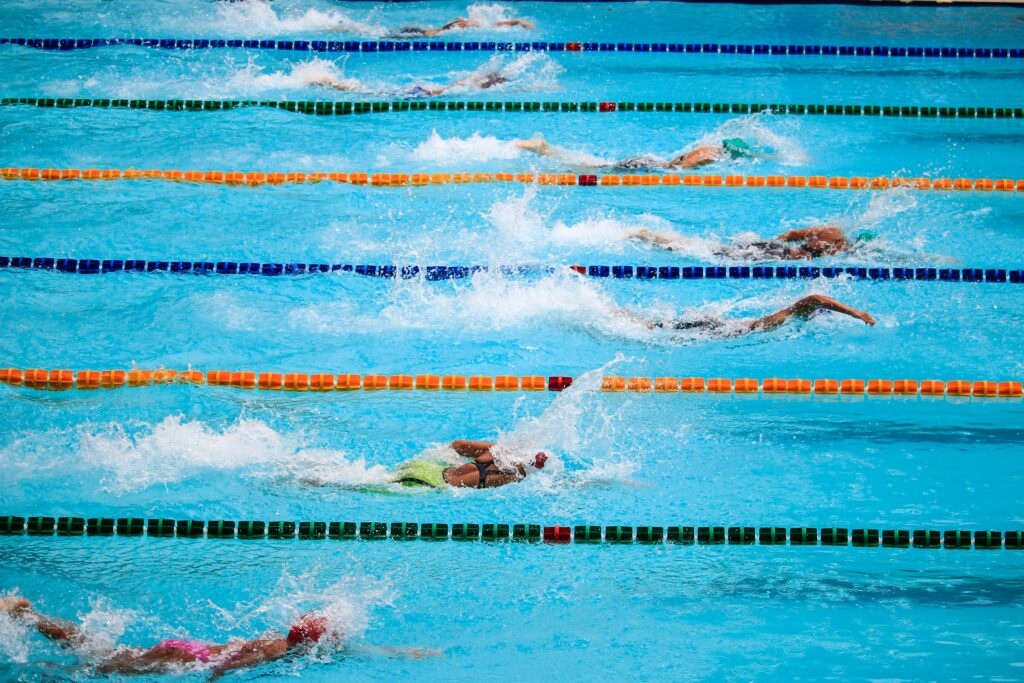Tech suits are an innovative form of swimwear designed to improve performance in competitive swimming. Constructed from highly advanced fabrics, these suits aim to enhance a swimmer’s speed and efficiency in the water. The primary fabric used in many tech suits is polyamide, a nylon-based fabric known for its comfort and its significant presence, ranging between 60-70% of the suit’s composition. Complementing polyamide is Lycra, making up approximately 30-40% of many tech suits and offering elasticity which ensures a snug fit and aids in muscle compression.
The functionality of tech suits lies in their ability to reduce drag, a critical factor in swimming performance. Their smooth, water-repellent surface allows swimmers to move through water with reduced resistance. By compressing certain muscle groups, tech suits also help in improving blood circulation and muscle oxygenation during performance, potentially aiding endurance and reducing fatigue.
Utilising materials that are both hydrophobic and finely woven, tech suits are engineered to decrease water absorption and assist in creating a streamlined profile. These characteristics enable swimmers to glide through water more efficiently, minimising the lag that can be caused by traditional swimwear. The integration of these high-technology fabrics and the resultant physical benefits signify the crucial role that tech suits play in the continual advancement of competitive swimming.

Overview of Tech Swimming Suits
Tech swimming suits represent a pivotal innovation in competitive swimming, utilising advanced materials and design to enhance performance. They are specifically engineered to minimise drag and provide muscular compression, two factors critical in achieving faster swim times.
Evolution of Competitive Swimwear
Since the inception of competitive swimming, the quest for speed has driven continual advancements in swimwear. Prior to the tech suit era, conventional materials like cotton and nylon were the norms. The turn of the millennium heralded a significant shift with the introduction of the Fastskin suits by Speedo, resembling shark skin and aiming to reduce drag. This paved the way for an evolution towards the high-tech fabrics seen in contemporary competitive swimwear. Regulatory body, FINA, has since played a crucial role in overseeing the balance between innovation and fair competition, placing restrictions on the extent of coverage and material properties since the 2009 World Championships where numerous world records were shattered.
The Role of Technology in Swimwear Design
Modern tech suits employ state-of-the-art technology to optimise swimmer performance. Utilising a blend of materials, such as polyamide and Lycra, designers aim to maximise comfort without compromising on the efficiency of the suit. The integral role of fabric technology in these suits is evidenced by their ability to compress muscles for improved blood circulation and reduced turbulence in the water, thus enabling swimmers to glide with less resistance. The careful engineering behind these garments embodies the peak of innovation in competitive swimwear design.
Key Features of Tech Suits
Tech suits, employed by competitive swimmers, provide a distinct advantage in the water by utilising advanced materials and design features. These suits enhance performance by offering muscle support and reducing drag, making them a staple in high-level aquatic competitions.
Materials Used in Tech Suits
The materials utilised in tech suits are integral to their performance-enhancing properties. A prevalent fabric is polyamide, a nylon-based material that ensures comfort and durability. Many tech suits incorporate a polyamide content of 60-70%, offering a solid foundation for the suit’s structure. Complementing polyamide, Lycra (or elastane), makes up roughly 30-40% of many suits, providing the necessary stretch and return to shape that is essential for competitive swimwear.
Compression and Muscle Support
Compression is a critical aspect of tech suits, designed to provide muscle support and stability. These suits strategically compress certain muscle groups, which can enhance blood circulation and reduce muscle oscillation during swimming. This, in turn, can lead to improved efficiency and reduced fatigue, allowing swimmers to perform at their peak for longer durations.
Hydrodynamic Properties
Tech suits are engineered to possess hydrodynamic qualities, which enable swimmers to slice through the water with minimal resistance. The surface of these suits is treated with a water-repellent coating, usually composed of polyurethane or other advancements, that significantly diminishes drag. This sleek exterior, along with the suit’s compressed and seamless design, results in a streamlined silhouette, enhancing the swimmer’s ability to move swiftly and efficiently through water.
Benefits of Wearing Tech Suits
The benefits of wearing tech suits in competitive swimming cannot be understated. They are specifically engineered to reduce drag and enhance buoyancy, thereby optimising swimming performance. With advanced fabrics and construction, these suits offer swimmers a tangible advantage in the water.
Reduced Drag and Improved Speed
Technical suits are crafted with smooth, water-repellant surfaces that reduce drag in the water. The strategic compression of these suits allows swimmers to maintain a more streamlined body shape, minimising resistance and facilitating improved speeds. The pivotal role of these suits in competitive scenarios is affirmed by their design to make athletes move through the water with greater efficiency.
Enhanced Buoyancy and Stability
Another key benefit of tech suits is their ability to provide enhanced buoyancy. This helps swimmers to maintain a higher position in the water, which can be critical in reducing total drag. In addition, the compression technology employed by these suits provides stability to the swimmer’s core, which is essential for maintaining an effective swimming technique throughout races.
Swimming Performance Enhancement
Ultimately, the primary benefit of tech suits is the overall enhancement of swimming performance. By combining the effects of reduced drag, improved speed, and increased buoyancy and stability, these swimwear options give competitive swimmers an edge. As the suit works to reduce drag and maintain a streamlined shape, swimmers can focus on their stroke and technique, capitalising on their training to achieve peak performance.
Fitting and Wearing Tech Suits
In competitive swimming, the right tech suit can significantly influence a swimmer’s performance. It’s essential that the fabric conforms snugly to the body, reducing drag and providing muscle compression without sacrificing comfort or range of motion.
Choosing the Right Tech Suit
When selecting a tech suit, size and fit are paramount. Swimmers should ensure the suit is snug but not restrictive, allowing for full body movement. Size charts provided by manufacturers can guide swimmers to the correct fit, but personal preference and body shape must also be considered. A tech suit that is too tight may hinder performance by restricting movement, while one that is too loose may not provide the necessary muscle compression.
- Fabric Composition: Tech suits typically comprise Polyamide and Lycra, offering a balance of compression and stretch. Polyamide fabrics, making up 60-70% of many suits, provide durability and fit, while Lycra—which usually accounts for approximately 30-40%—ensures the suit adheres closely to the swimmer’s body.
- Brand and Model: Different brands and models have specific features aimed at enhancing performance in various strokes and distances. Some suits may offer more compression, while others focus on flexibility.

Correct Fitting for Optimum Performance
The correct fitting of a tech suit is imperative for optimum performance. Swimmers may need assistance when wearing their tech suits as the process is meticulous and caution is advised to avoid damaging the delicate fabric. A practical tip for donning a tech suit is the use of plastic bags to help the legs slide through the suit more easily, a technique highlighted in the comprehensive fit guide for tech suits.
- Putting on the Suit: The process involves carefully pulling the suit up on each leg, alternating to ensure the suit is evenly fitted. The suit should sit just below the knees before being eased over them.
- Adjusting for Comfort: Once on, the tech suit should compress the muscles without cutting off circulation or limiting the swimmer’s range of motion. Swimmers should check for wrinkles or air pockets that can cause drag in the water, indicating a poor fit.
In short, the tech suit should act as a second skin, offering a balance of compression and elasticity to aid the swimmer’s glide through the water. Properly fitting a tech suit is a critical part of a swimmer’s preparation, one that can have a tangible effect on their swimming efficiency and overall performance.
Regulations and Standards
In the domain of competitive swimming, the regulations and standards set by the governing bodies are as crucial as the physical training of the athletes. These standards ensure fair competition and maintain the integrity of the sport by regulating swimwear technology and its impact on performance.
FINA-Approved Swimwear
The International Swimming Federation, known as FINA, is the organisation responsible for maintaining the rules which govern swimwear in competitive swimming. FINA-approved suits must adhere to specific material, construction, and coverage criteria. These regulations are periodically updated to balance technological innovation with the need to keep competitions fair. For instance, suits must not cover the neck, extend past the shoulders, nor go beyond the knees.
Swimwear that meets these criteria is added to a FINA-approved list, which swimmers must consult before selecting a suit for competition. The performance of athletes in the water is significantly influenced by the fabric of their suits, and FINA’s role is to ensure that no swimmer gains an unfair advantage through their choice of attire.
Impact of Regulations on Suit Design
The regulations set by FINA have a direct impact on the design and technology of competitive swimwear. Manufacturers must innovate within these constraints, focusing on fabric composition, seam construction, and surface treatment to enhance hydrodynamics legally. The changing standards can promote shifts in the industry—as seen with the ban of full-body polyurethane suits—leading to a continuous cycle of adaptation and re-engineering.
As a result, suit design is a field of constant evolution, where the goal is to boost the swimmer’s performance through reduced drag and improved muscle compression without violating regulations. The challenge for manufacturers is to find compliant materials that are lightweight, water-resistant, and able to offer the necessary compression and freedom of movement.
Training and Performance
In competitive swimming, the integration of tech suits into both training and competition significantly impacts an athlete’s performance and technique optimisation. These suits affect how swimmers train and perform, influencing stroke rate and speed.
Influence of Tech Suits on Training
While tech suits are primarily worn during competitions, their impact on training cannot be overlooked. They are designed to compress the swimmer’s muscles, leading to increased proprioception—awareness of the body in space—which can aid in the simulation of race conditions during practice sessions. This compression also helps promote blood circulation, potentially aiding recovery between training sets. These benefits, however, should be carefully balanced; swimmers may wear these suits strategically during training to adjust to the suit’s feel without becoming overly reliant on it for muscle support.
Improvement of Stroke and Technique
The design of tech suits is focused on enhancing a swimmer’s hydrodynamics, effectively improving stroke efficiency and technique. The fabric of the suit works by reducing drag, allowing for a smoother and faster swim. The outcome is an optimisation of the swimmer’s form, as the reduced resistance can lead to a more effective stroke and a potential increase in stroke rate and speed. Swimmers may find that their movements become more streamlined, encouraging a focus on maintaining proper technique to fully utilise the suit’s properties.

Impact on Competitive Swimming
The introduction of high-performance tech suits has dramatically influenced competitive swimming, with marked improvements in records and the psychological state of the athletes. These enhancements stem from the design and materials employed in the suits’ construction.
Records and Milestones
Tech suits have been at the forefront of many swimming milestones due to their design that is engineered to reduce drag and provide muscle compression. The timeline of competitive swimwear evolution spotlights significant moments when new materials and designs were introduced, leading to numerous world records being shattered. For example, the introduction of full-body swimsuits in the year 2000 led to a surge in performance, with studies demonstrating men’s freestyle records improving by 0.9 to 1.4%. Further advancements such as polyurethane panels introduced in 2008 saw an additional increase in performance by 1.5 to 3.5%. Renowned swimmers, such as Michael Phelps, donned these tech suits during their competitions, often emerging victorious and setting new world records.
Psychological Advantages for Swimmers
Beyond the physical benefits, tech suits offer significant psychological advantages to competitive swimmers. An athlete’s confidence can be bolstered by wearing a suit that is known for aiding performance. This confidence in their gear can translate into better performance, as swimmers feel more prepared to compete at their highest level. The sense of having an edge over competitors who may not be equipped with the latest technology can provide a mental boost, further contributing to the possibility of record-breaking swims. It is this intersection of mental and physical readiness that tech suits have cultivated, cementing their role in the sport of competitive swimming.
Technical Considerations
In the realm of competitive swimming, the technical suit has undergone meticulous design enhancements to optimise performance. Key areas of focus include the innovation in construction and seam technology, alongside the careful balancing of suit thickness to ensure a full range of motion for athletes.
Construction and Seam Technology
Seams are a critical aspect when it comes to the construction of a technical suit. They are strategically placed to support and align with a swimmer’s muscle groups and body position during various strokes. Bonded seams are commonly utilised due to their low profile, which aids in reducing drag and enhancing the hydrodynamic efficiency of the swimmer. This seamless construction also contributes to the durability of the suit. Studies like those referenced in Xtreme Swim Blog suggest that reduced drag is crucial in maintaining high speeds in the water.
Suit Thickness and Range of Motion
Technical suits also differ in thickness, which is fine-tuned to provide a balance between compression and flexibility. It is engineered to ensure swimmers maintain an optimal range of motion, which is vital for executing efficient and powerful strokes. The material’s composition, often a blend of polyamide and Lycra, offers enough elasticity for freedom of movement while still applying the necessary pressure to streamline the body. Information from sources like Swim Competitive indicates that the proportion of materials like polyamide can affect both comfort and performance. The integration of such materials into the suit’s design is therefore critical to achieving the desired outcome of enhanced swimming mechanics.

Maintenance and Care
Proper maintenance of tech swimming suits is crucial to their longevity and durability. By adhering to care recommendations, swimmers can ensure that their investment retains optimal functionality over time.
Proper Care for Longevity
Tech suits require specific care routines to maintain their integrity and performance-enhancing properties. After each use, rinsing the suit in cold water removes chlorine and other chemicals that can break down the suit’s fabric. Suits should be air-dried away from direct sunlight and heat sources to prevent the material from weakening. Swimmers should avoid wringing out their suits, as this can damage the fibres and affect the suit’s shape.
Durability and Care Recommendations
The durability of a tech suit can be sustained through careful handling. When putting on the suit, swimmers should use their fingertips rather than their nails to avoid tears in the material. It’s advisable to avoid grasping the fabric with fingernails directly. Repetitive exposure to harsh conditions without proper care can reduce the suit’s lifespan, so it is recommended to use the suit exclusively for races and not regular training sessions. It is worth noting that with proper maintenance, one could significantly extend the wearable life of their tech suit, emphasising the value of diligent care.
Cost Considerations
When evaluating tech swimming suits, one must consider the spectrum of prices and the potential return on investment. There is a significant variance between high-end and budget options, which necessitates a cost-benefit analysis tailored to individual swimmers’ needs.
High-end vs. Budget Tech Suits
High-end tech suits often incorporate advanced materials and technologies that aim to reduce drag and improve performance. These suits are typically composed of nylon-based fabric such as Polyamide, and can include a high percentage of Lycra. They might feature innovations such as ultrasonically welded seams and water-repellent coatings. However, such features come at a cost. The price for flagship tech suits averages around £440.09, with variations depending on whether the suit is for men or women.
In contrast, budget tech suits offer swimmers a more affordable entry point into the technical swimwear market. These suits may not include the same level of fabric engineering or the advanced features found in their high-end counterparts, but they still provide a performance boost over traditional swimsuits.
Cost-Benefit Analysis for Swimmers
Swimmers must weigh the expected performance gains against the financial outlay for a tech suit. A flagship tech suit represents a significant investment, and whether this is justifiable depends on the level of competition and the value the swimmer places on marginal gains. Conversely, budget tech suits might provide a more cost-effective solution that balances performance enhancement with fiscal prudence.
It’s essential for swimmers to consider not only the immediate cost but also the durability and longevity of the suit, as frequent replacement can increase overall expenses. Regardless of the decision, a thorough analysis of the price against the performance benefits and the individual’s competitive goals will guide swimmers to the most prudent purchase.
Frequently Asked Questions
Tech swimming suits are engineered to enhance performance. They’re made with advanced fabrics designed for speed, compression, and reduced drag. Here are some common queries regarding their function and design.
What are the benefits of wearing a tech suit for swimming?
A tech suit provides swimmers with reduced drag and increased compression. This allows for a more hydrodynamic shape in the water, leading to potential improvements in speed and performance.
What compositions of fabric are utilised in the manufacture of tech suits?
Tech suits are typically made from a blend of high-performance materials like nylon, spandex, and polyurethane. These fabrics are chosen for their ability to compress the body and repel water, contributing to a swimmer’s efficiency in the water.
How do tech swimming suits improve performance in the water?
Tech suits improve performance by reducing water resistance through their unique fabric composition and seamless construction. Their tight fit also supports muscle efficiency and can help in maintaining optimal body alignment while swimming.
What is the typical lifespan of a high-tech swimming suit?
The lifespan of a high-tech swimming suit can vary depending on its use and care, but typically they are constructed to withstand the rigours of competitive swimming for a season, which might equate to several months of regular use.
Why is there a significant cost associated with swimming tech suits?
The cost of swimming tech suits is attributed to the advanced materials and construction techniques used in their design. They incorporate the latest innovations in fabric technology and testing to achieve the goals of compression and drag reduction, which in turn demands a higher price point.
In what ways do technical swimming suits differ from conventional swimwear?
Technical swimming suits are purposefully crafted to maximise a swimmer’s speed and efficiency in the water, whereas conventional swimwear is designed for comfort and versatility without the same level of performance-enhancing features.







